Human Resource Management Report - HRM Assignment, Semester 1
VerifiedAdded on 2019/12/18
|16
|5625
|210
Report
AI Summary
This report provides a comprehensive overview of Human Resource Management (HRM), differentiating it from personnel management and highlighting its crucial role in organizational success. It explores key HRM functions like recruitment, selection, orientation, employee relations, and training and development, emphasizing the significance of line managers in these processes. The report delves into human resource planning, outlining its reasons and stages, alongside a comparative analysis of recruitment and selection processes in different organizations. Furthermore, it examines motivational theories, reward systems, job evaluation, and performance monitoring methods. The impact of legal and regulatory frameworks on HRM practices, including employment cessation, is also discussed, offering a holistic understanding of the subject.
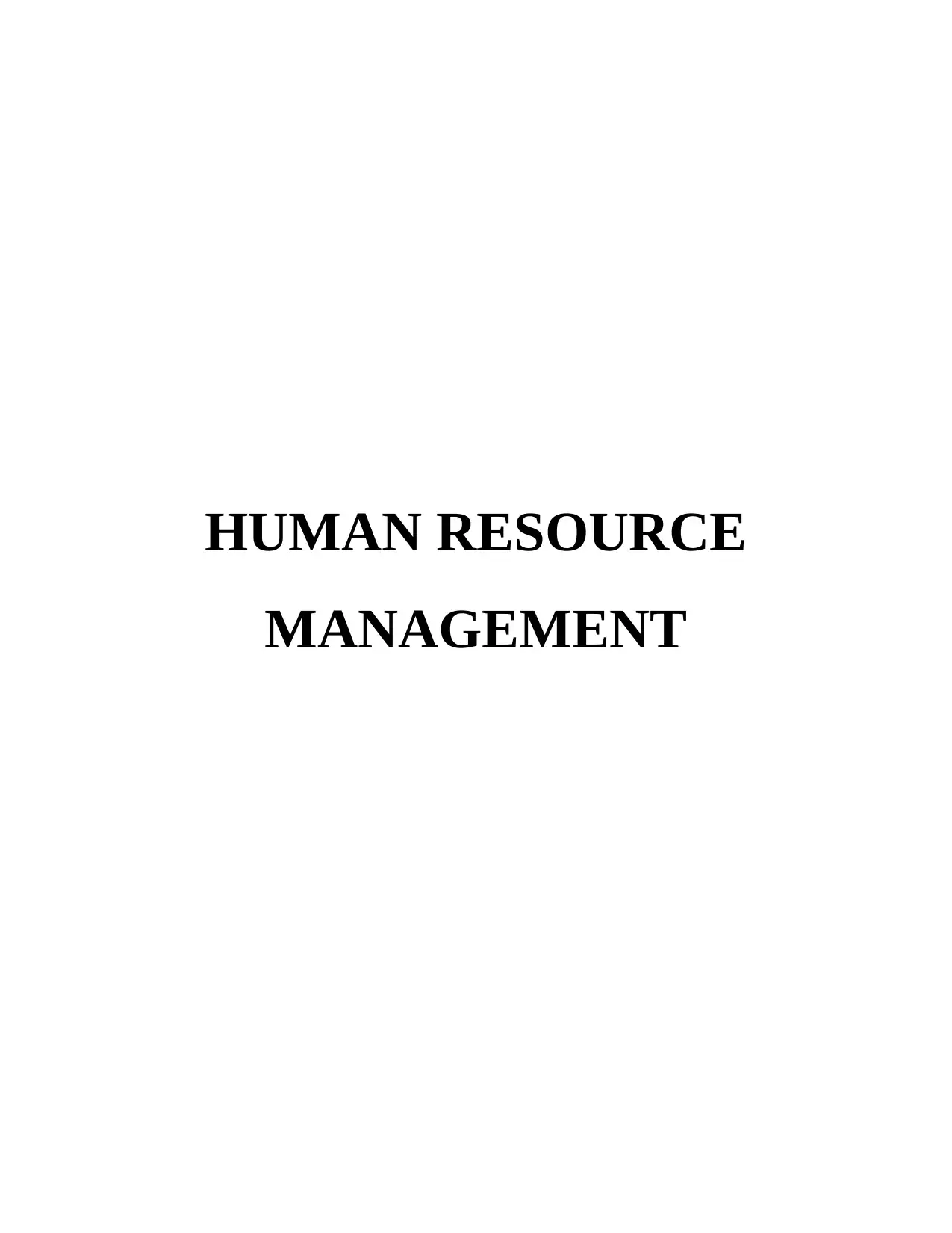
HUMAN RESOURCE
MANAGEMENT
MANAGEMENT
Paraphrase This Document
Need a fresh take? Get an instant paraphrase of this document with our AI Paraphraser
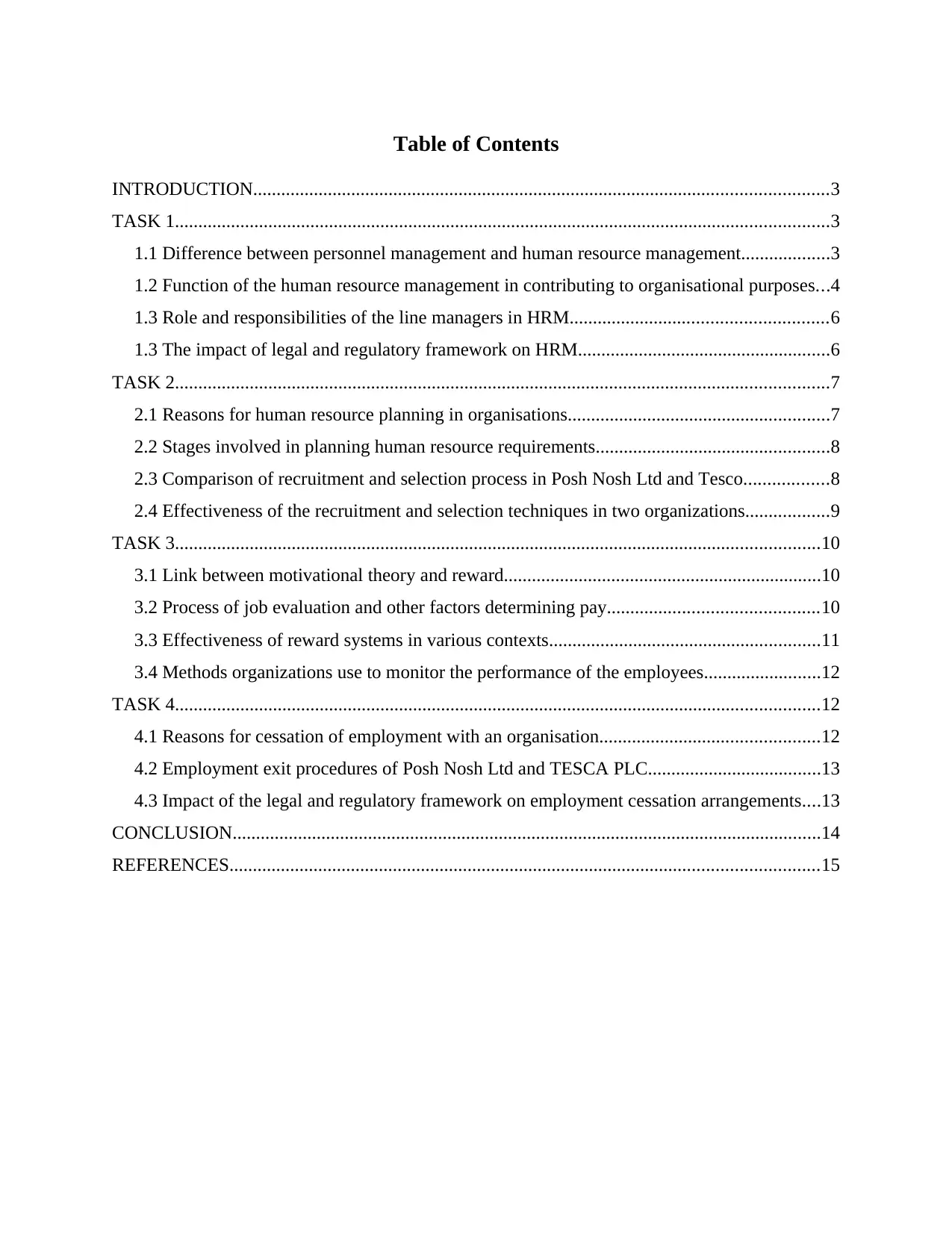
Table of Contents
INTRODUCTION...........................................................................................................................3
TASK 1............................................................................................................................................3
1.1 Difference between personnel management and human resource management...................3
1.2 Function of the human resource management in contributing to organisational purposes...4
1.3 Role and responsibilities of the line managers in HRM.......................................................6
1.3 The impact of legal and regulatory framework on HRM......................................................6
TASK 2............................................................................................................................................7
2.1 Reasons for human resource planning in organisations........................................................7
2.2 Stages involved in planning human resource requirements..................................................8
2.3 Comparison of recruitment and selection process in Posh Nosh Ltd and Tesco..................8
2.4 Effectiveness of the recruitment and selection techniques in two organizations..................9
TASK 3..........................................................................................................................................10
3.1 Link between motivational theory and reward....................................................................10
3.2 Process of job evaluation and other factors determining pay.............................................10
3.3 Effectiveness of reward systems in various contexts..........................................................11
3.4 Methods organizations use to monitor the performance of the employees.........................12
TASK 4..........................................................................................................................................12
4.1 Reasons for cessation of employment with an organisation...............................................12
4.2 Employment exit procedures of Posh Nosh Ltd and TESCA PLC.....................................13
4.3 Impact of the legal and regulatory framework on employment cessation arrangements....13
CONCLUSION..............................................................................................................................14
REFERENCES..............................................................................................................................15
INTRODUCTION...........................................................................................................................3
TASK 1............................................................................................................................................3
1.1 Difference between personnel management and human resource management...................3
1.2 Function of the human resource management in contributing to organisational purposes...4
1.3 Role and responsibilities of the line managers in HRM.......................................................6
1.3 The impact of legal and regulatory framework on HRM......................................................6
TASK 2............................................................................................................................................7
2.1 Reasons for human resource planning in organisations........................................................7
2.2 Stages involved in planning human resource requirements..................................................8
2.3 Comparison of recruitment and selection process in Posh Nosh Ltd and Tesco..................8
2.4 Effectiveness of the recruitment and selection techniques in two organizations..................9
TASK 3..........................................................................................................................................10
3.1 Link between motivational theory and reward....................................................................10
3.2 Process of job evaluation and other factors determining pay.............................................10
3.3 Effectiveness of reward systems in various contexts..........................................................11
3.4 Methods organizations use to monitor the performance of the employees.........................12
TASK 4..........................................................................................................................................12
4.1 Reasons for cessation of employment with an organisation...............................................12
4.2 Employment exit procedures of Posh Nosh Ltd and TESCA PLC.....................................13
4.3 Impact of the legal and regulatory framework on employment cessation arrangements....13
CONCLUSION..............................................................................................................................14
REFERENCES..............................................................................................................................15
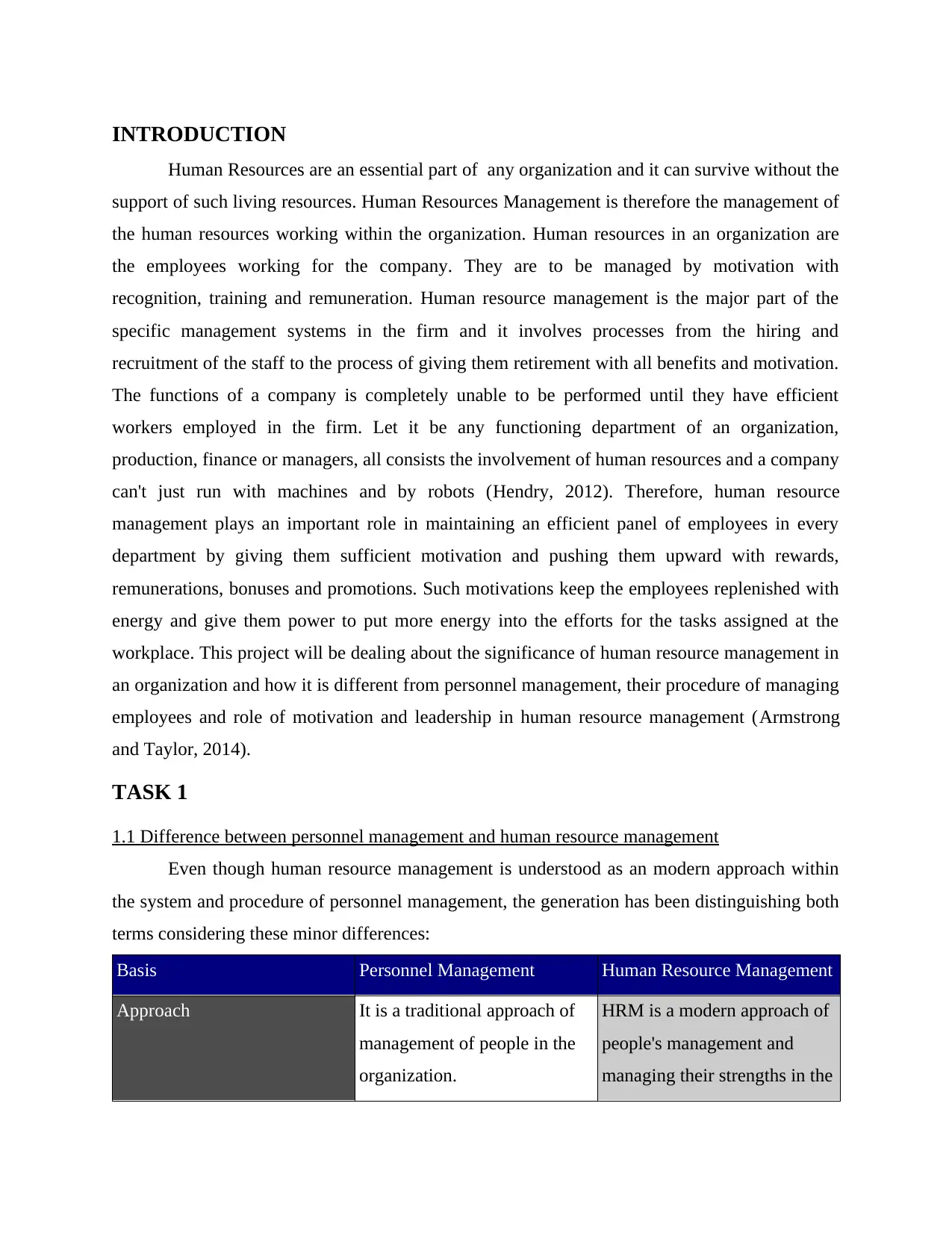
INTRODUCTION
Human Resources are an essential part of any organization and it can survive without the
support of such living resources. Human Resources Management is therefore the management of
the human resources working within the organization. Human resources in an organization are
the employees working for the company. They are to be managed by motivation with
recognition, training and remuneration. Human resource management is the major part of the
specific management systems in the firm and it involves processes from the hiring and
recruitment of the staff to the process of giving them retirement with all benefits and motivation.
The functions of a company is completely unable to be performed until they have efficient
workers employed in the firm. Let it be any functioning department of an organization,
production, finance or managers, all consists the involvement of human resources and a company
can't just run with machines and by robots (Hendry, 2012). Therefore, human resource
management plays an important role in maintaining an efficient panel of employees in every
department by giving them sufficient motivation and pushing them upward with rewards,
remunerations, bonuses and promotions. Such motivations keep the employees replenished with
energy and give them power to put more energy into the efforts for the tasks assigned at the
workplace. This project will be dealing about the significance of human resource management in
an organization and how it is different from personnel management, their procedure of managing
employees and role of motivation and leadership in human resource management (Armstrong
and Taylor, 2014).
TASK 1
1.1 Difference between personnel management and human resource management
Even though human resource management is understood as an modern approach within
the system and procedure of personnel management, the generation has been distinguishing both
terms considering these minor differences:
Basis Personnel Management Human Resource Management
Approach It is a traditional approach of
management of people in the
organization.
HRM is a modern approach of
people's management and
managing their strengths in the
Human Resources are an essential part of any organization and it can survive without the
support of such living resources. Human Resources Management is therefore the management of
the human resources working within the organization. Human resources in an organization are
the employees working for the company. They are to be managed by motivation with
recognition, training and remuneration. Human resource management is the major part of the
specific management systems in the firm and it involves processes from the hiring and
recruitment of the staff to the process of giving them retirement with all benefits and motivation.
The functions of a company is completely unable to be performed until they have efficient
workers employed in the firm. Let it be any functioning department of an organization,
production, finance or managers, all consists the involvement of human resources and a company
can't just run with machines and by robots (Hendry, 2012). Therefore, human resource
management plays an important role in maintaining an efficient panel of employees in every
department by giving them sufficient motivation and pushing them upward with rewards,
remunerations, bonuses and promotions. Such motivations keep the employees replenished with
energy and give them power to put more energy into the efforts for the tasks assigned at the
workplace. This project will be dealing about the significance of human resource management in
an organization and how it is different from personnel management, their procedure of managing
employees and role of motivation and leadership in human resource management (Armstrong
and Taylor, 2014).
TASK 1
1.1 Difference between personnel management and human resource management
Even though human resource management is understood as an modern approach within
the system and procedure of personnel management, the generation has been distinguishing both
terms considering these minor differences:
Basis Personnel Management Human Resource Management
Approach It is a traditional approach of
management of people in the
organization.
HRM is a modern approach of
people's management and
managing their strengths in the
⊘ This is a preview!⊘
Do you want full access?
Subscribe today to unlock all pages.

Trusted by 1+ million students worldwide
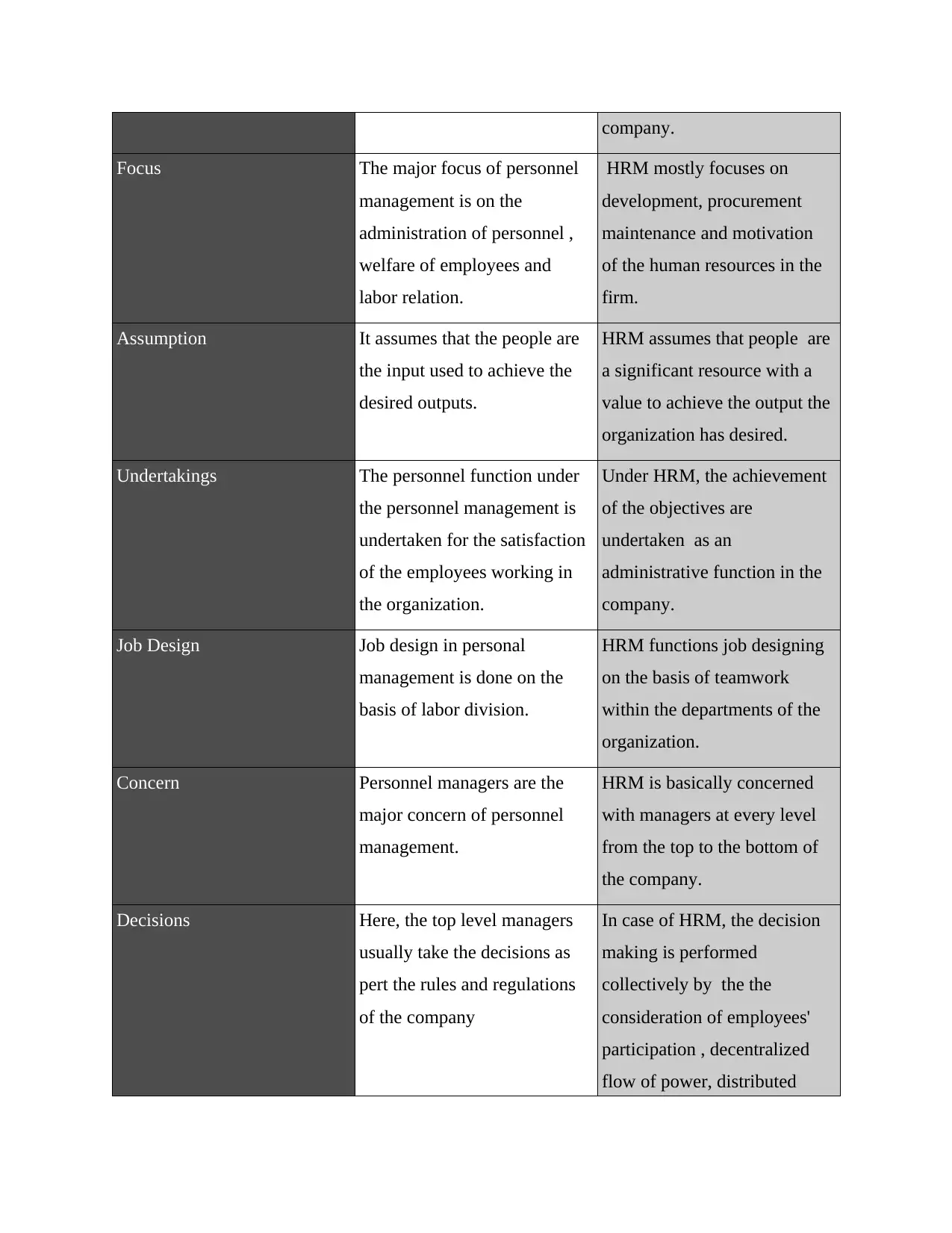
company.
Focus The major focus of personnel
management is on the
administration of personnel ,
welfare of employees and
labor relation.
HRM mostly focuses on
development, procurement
maintenance and motivation
of the human resources in the
firm.
Assumption It assumes that the people are
the input used to achieve the
desired outputs.
HRM assumes that people are
a significant resource with a
value to achieve the output the
organization has desired.
Undertakings The personnel function under
the personnel management is
undertaken for the satisfaction
of the employees working in
the organization.
Under HRM, the achievement
of the objectives are
undertaken as an
administrative function in the
company.
Job Design Job design in personal
management is done on the
basis of labor division.
HRM functions job designing
on the basis of teamwork
within the departments of the
organization.
Concern Personnel managers are the
major concern of personnel
management.
HRM is basically concerned
with managers at every level
from the top to the bottom of
the company.
Decisions Here, the top level managers
usually take the decisions as
pert the rules and regulations
of the company
In case of HRM, the decision
making is performed
collectively by the the
consideration of employees'
participation , decentralized
flow of power, distributed
Focus The major focus of personnel
management is on the
administration of personnel ,
welfare of employees and
labor relation.
HRM mostly focuses on
development, procurement
maintenance and motivation
of the human resources in the
firm.
Assumption It assumes that the people are
the input used to achieve the
desired outputs.
HRM assumes that people are
a significant resource with a
value to achieve the output the
organization has desired.
Undertakings The personnel function under
the personnel management is
undertaken for the satisfaction
of the employees working in
the organization.
Under HRM, the achievement
of the objectives are
undertaken as an
administrative function in the
company.
Job Design Job design in personal
management is done on the
basis of labor division.
HRM functions job designing
on the basis of teamwork
within the departments of the
organization.
Concern Personnel managers are the
major concern of personnel
management.
HRM is basically concerned
with managers at every level
from the top to the bottom of
the company.
Decisions Here, the top level managers
usually take the decisions as
pert the rules and regulations
of the company
In case of HRM, the decision
making is performed
collectively by the the
consideration of employees'
participation , decentralized
flow of power, distributed
Paraphrase This Document
Need a fresh take? Get an instant paraphrase of this document with our AI Paraphraser
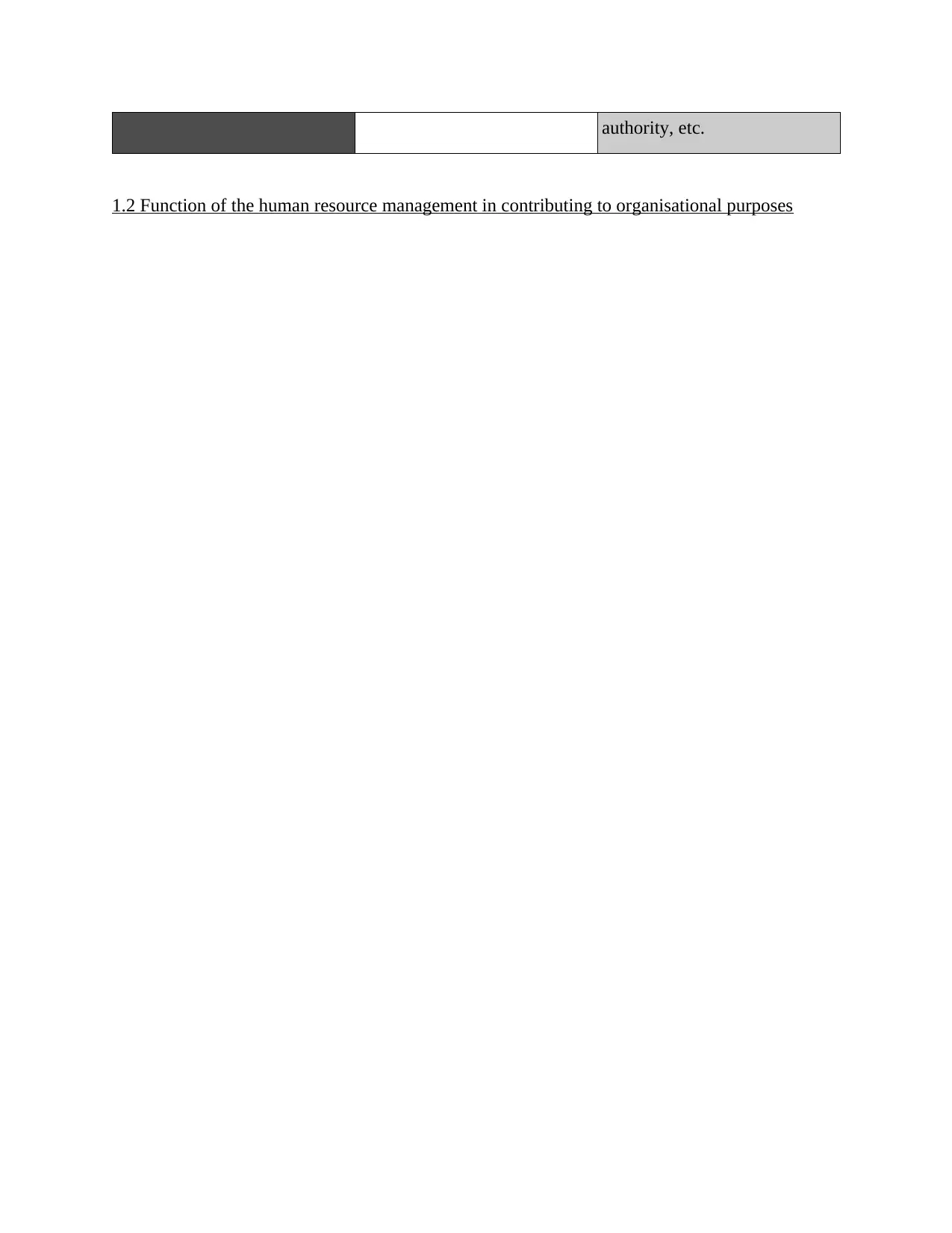
authority, etc.
1.2 Function of the human resource management in contributing to organisational purposes
1.2 Function of the human resource management in contributing to organisational purposes
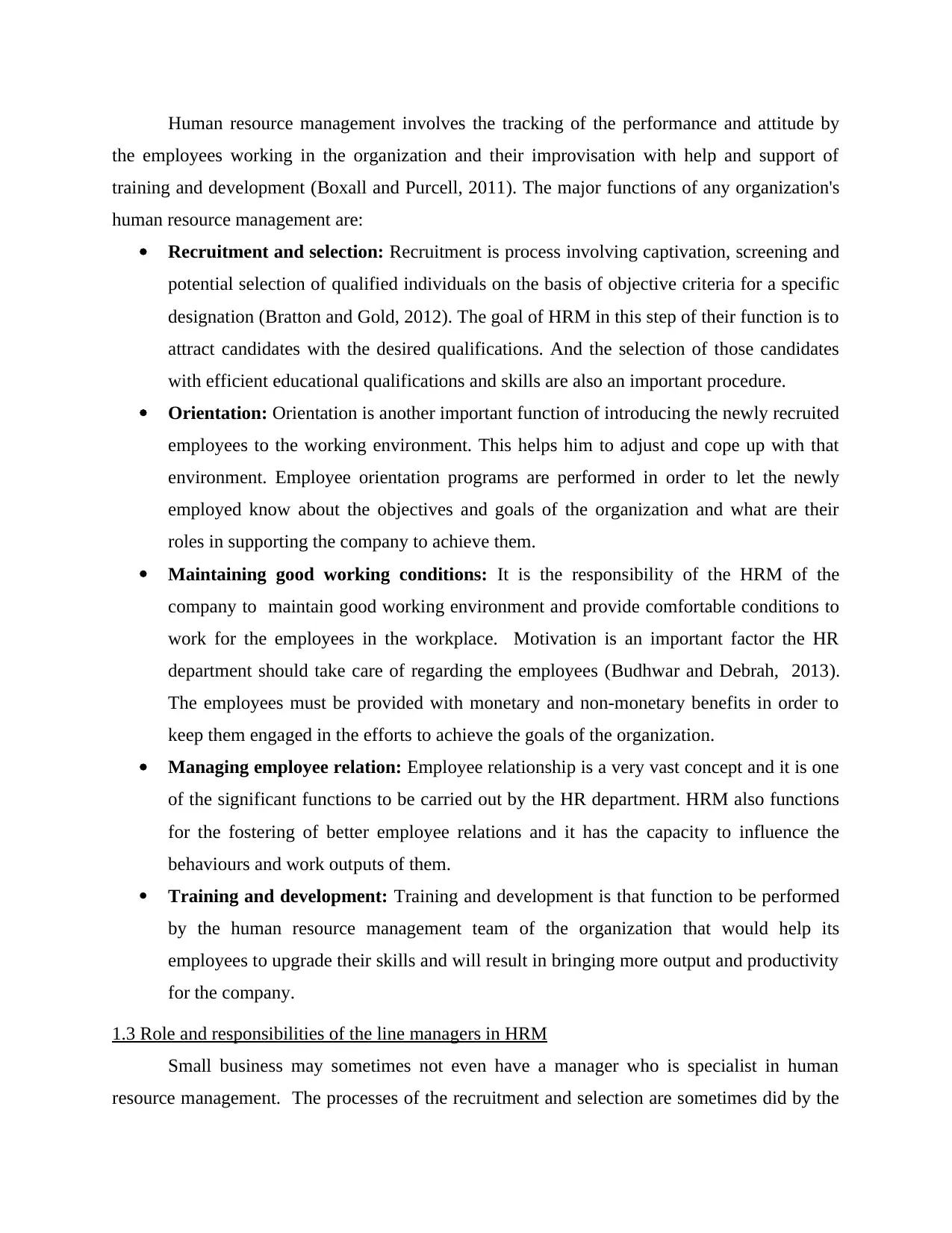
Human resource management involves the tracking of the performance and attitude by
the employees working in the organization and their improvisation with help and support of
training and development (Boxall and Purcell, 2011). The major functions of any organization's
human resource management are:
Recruitment and selection: Recruitment is process involving captivation, screening and
potential selection of qualified individuals on the basis of objective criteria for a specific
designation (Bratton and Gold, 2012). The goal of HRM in this step of their function is to
attract candidates with the desired qualifications. And the selection of those candidates
with efficient educational qualifications and skills are also an important procedure.
Orientation: Orientation is another important function of introducing the newly recruited
employees to the working environment. This helps him to adjust and cope up with that
environment. Employee orientation programs are performed in order to let the newly
employed know about the objectives and goals of the organization and what are their
roles in supporting the company to achieve them.
Maintaining good working conditions: It is the responsibility of the HRM of the
company to maintain good working environment and provide comfortable conditions to
work for the employees in the workplace. Motivation is an important factor the HR
department should take care of regarding the employees (Budhwar and Debrah, 2013).
The employees must be provided with monetary and non-monetary benefits in order to
keep them engaged in the efforts to achieve the goals of the organization.
Managing employee relation: Employee relationship is a very vast concept and it is one
of the significant functions to be carried out by the HR department. HRM also functions
for the fostering of better employee relations and it has the capacity to influence the
behaviours and work outputs of them.
Training and development: Training and development is that function to be performed
by the human resource management team of the organization that would help its
employees to upgrade their skills and will result in bringing more output and productivity
for the company.
1.3 Role and responsibilities of the line managers in HRM
Small business may sometimes not even have a manager who is specialist in human
resource management. The processes of the recruitment and selection are sometimes did by the
the employees working in the organization and their improvisation with help and support of
training and development (Boxall and Purcell, 2011). The major functions of any organization's
human resource management are:
Recruitment and selection: Recruitment is process involving captivation, screening and
potential selection of qualified individuals on the basis of objective criteria for a specific
designation (Bratton and Gold, 2012). The goal of HRM in this step of their function is to
attract candidates with the desired qualifications. And the selection of those candidates
with efficient educational qualifications and skills are also an important procedure.
Orientation: Orientation is another important function of introducing the newly recruited
employees to the working environment. This helps him to adjust and cope up with that
environment. Employee orientation programs are performed in order to let the newly
employed know about the objectives and goals of the organization and what are their
roles in supporting the company to achieve them.
Maintaining good working conditions: It is the responsibility of the HRM of the
company to maintain good working environment and provide comfortable conditions to
work for the employees in the workplace. Motivation is an important factor the HR
department should take care of regarding the employees (Budhwar and Debrah, 2013).
The employees must be provided with monetary and non-monetary benefits in order to
keep them engaged in the efforts to achieve the goals of the organization.
Managing employee relation: Employee relationship is a very vast concept and it is one
of the significant functions to be carried out by the HR department. HRM also functions
for the fostering of better employee relations and it has the capacity to influence the
behaviours and work outputs of them.
Training and development: Training and development is that function to be performed
by the human resource management team of the organization that would help its
employees to upgrade their skills and will result in bringing more output and productivity
for the company.
1.3 Role and responsibilities of the line managers in HRM
Small business may sometimes not even have a manager who is specialist in human
resource management. The processes of the recruitment and selection are sometimes did by the
⊘ This is a preview!⊘
Do you want full access?
Subscribe today to unlock all pages.

Trusted by 1+ million students worldwide
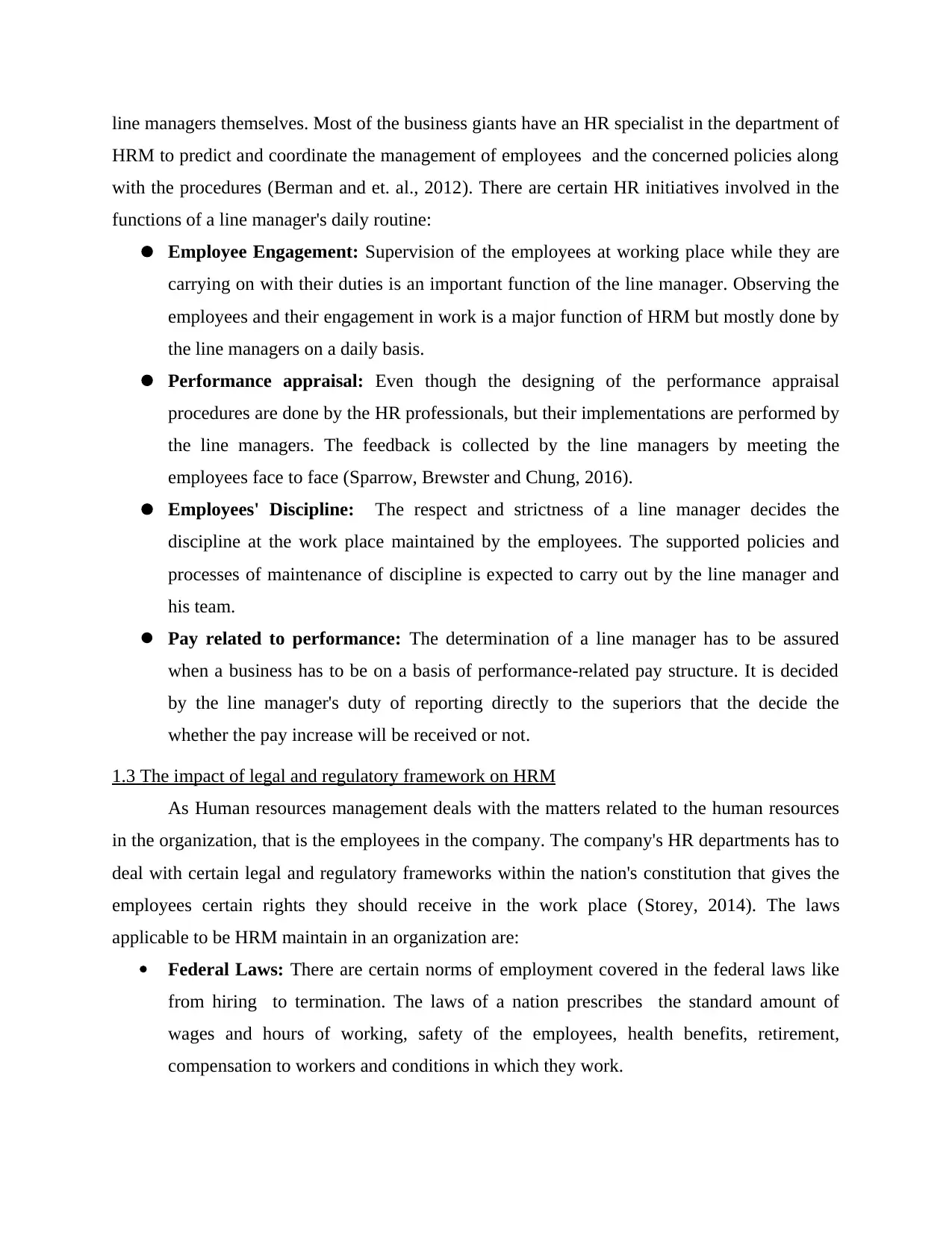
line managers themselves. Most of the business giants have an HR specialist in the department of
HRM to predict and coordinate the management of employees and the concerned policies along
with the procedures (Berman and et. al., 2012). There are certain HR initiatives involved in the
functions of a line manager's daily routine:
Employee Engagement: Supervision of the employees at working place while they are
carrying on with their duties is an important function of the line manager. Observing the
employees and their engagement in work is a major function of HRM but mostly done by
the line managers on a daily basis.
Performance appraisal: Even though the designing of the performance appraisal
procedures are done by the HR professionals, but their implementations are performed by
the line managers. The feedback is collected by the line managers by meeting the
employees face to face (Sparrow, Brewster and Chung, 2016).
Employees' Discipline: The respect and strictness of a line manager decides the
discipline at the work place maintained by the employees. The supported policies and
processes of maintenance of discipline is expected to carry out by the line manager and
his team.
Pay related to performance: The determination of a line manager has to be assured
when a business has to be on a basis of performance-related pay structure. It is decided
by the line manager's duty of reporting directly to the superiors that the decide the
whether the pay increase will be received or not.
1.3 The impact of legal and regulatory framework on HRM
As Human resources management deals with the matters related to the human resources
in the organization, that is the employees in the company. The company's HR departments has to
deal with certain legal and regulatory frameworks within the nation's constitution that gives the
employees certain rights they should receive in the work place (Storey, 2014). The laws
applicable to be HRM maintain in an organization are:
Federal Laws: There are certain norms of employment covered in the federal laws like
from hiring to termination. The laws of a nation prescribes the standard amount of
wages and hours of working, safety of the employees, health benefits, retirement,
compensation to workers and conditions in which they work.
HRM to predict and coordinate the management of employees and the concerned policies along
with the procedures (Berman and et. al., 2012). There are certain HR initiatives involved in the
functions of a line manager's daily routine:
Employee Engagement: Supervision of the employees at working place while they are
carrying on with their duties is an important function of the line manager. Observing the
employees and their engagement in work is a major function of HRM but mostly done by
the line managers on a daily basis.
Performance appraisal: Even though the designing of the performance appraisal
procedures are done by the HR professionals, but their implementations are performed by
the line managers. The feedback is collected by the line managers by meeting the
employees face to face (Sparrow, Brewster and Chung, 2016).
Employees' Discipline: The respect and strictness of a line manager decides the
discipline at the work place maintained by the employees. The supported policies and
processes of maintenance of discipline is expected to carry out by the line manager and
his team.
Pay related to performance: The determination of a line manager has to be assured
when a business has to be on a basis of performance-related pay structure. It is decided
by the line manager's duty of reporting directly to the superiors that the decide the
whether the pay increase will be received or not.
1.3 The impact of legal and regulatory framework on HRM
As Human resources management deals with the matters related to the human resources
in the organization, that is the employees in the company. The company's HR departments has to
deal with certain legal and regulatory frameworks within the nation's constitution that gives the
employees certain rights they should receive in the work place (Storey, 2014). The laws
applicable to be HRM maintain in an organization are:
Federal Laws: There are certain norms of employment covered in the federal laws like
from hiring to termination. The laws of a nation prescribes the standard amount of
wages and hours of working, safety of the employees, health benefits, retirement,
compensation to workers and conditions in which they work.
Paraphrase This Document
Need a fresh take? Get an instant paraphrase of this document with our AI Paraphraser
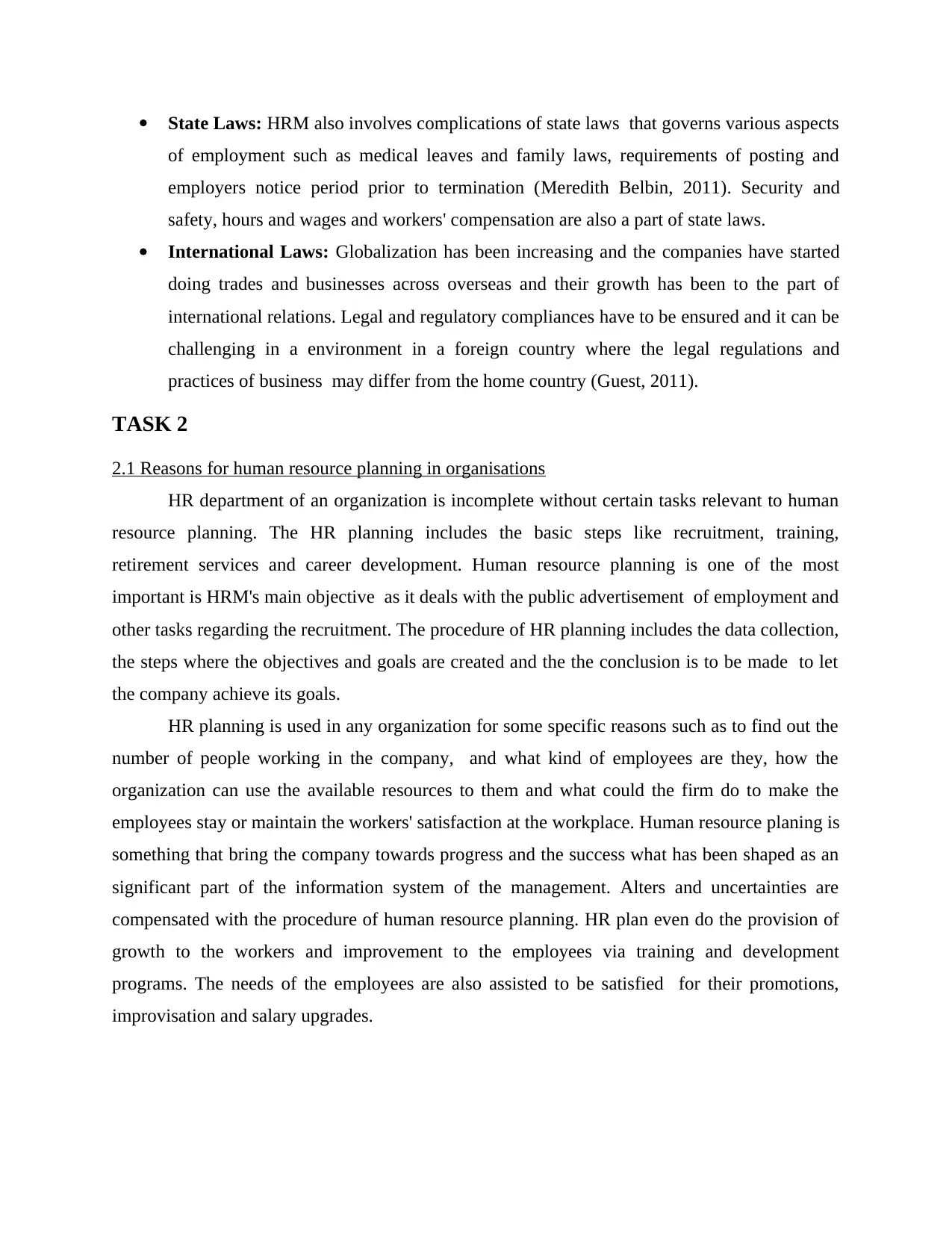
State Laws: HRM also involves complications of state laws that governs various aspects
of employment such as medical leaves and family laws, requirements of posting and
employers notice period prior to termination (Meredith Belbin, 2011). Security and
safety, hours and wages and workers' compensation are also a part of state laws.
International Laws: Globalization has been increasing and the companies have started
doing trades and businesses across overseas and their growth has been to the part of
international relations. Legal and regulatory compliances have to be ensured and it can be
challenging in a environment in a foreign country where the legal regulations and
practices of business may differ from the home country (Guest, 2011).
TASK 2
2.1 Reasons for human resource planning in organisations
HR department of an organization is incomplete without certain tasks relevant to human
resource planning. The HR planning includes the basic steps like recruitment, training,
retirement services and career development. Human resource planning is one of the most
important is HRM's main objective as it deals with the public advertisement of employment and
other tasks regarding the recruitment. The procedure of HR planning includes the data collection,
the steps where the objectives and goals are created and the the conclusion is to be made to let
the company achieve its goals.
HR planning is used in any organization for some specific reasons such as to find out the
number of people working in the company, and what kind of employees are they, how the
organization can use the available resources to them and what could the firm do to make the
employees stay or maintain the workers' satisfaction at the workplace. Human resource planing is
something that bring the company towards progress and the success what has been shaped as an
significant part of the information system of the management. Alters and uncertainties are
compensated with the procedure of human resource planning. HR plan even do the provision of
growth to the workers and improvement to the employees via training and development
programs. The needs of the employees are also assisted to be satisfied for their promotions,
improvisation and salary upgrades.
of employment such as medical leaves and family laws, requirements of posting and
employers notice period prior to termination (Meredith Belbin, 2011). Security and
safety, hours and wages and workers' compensation are also a part of state laws.
International Laws: Globalization has been increasing and the companies have started
doing trades and businesses across overseas and their growth has been to the part of
international relations. Legal and regulatory compliances have to be ensured and it can be
challenging in a environment in a foreign country where the legal regulations and
practices of business may differ from the home country (Guest, 2011).
TASK 2
2.1 Reasons for human resource planning in organisations
HR department of an organization is incomplete without certain tasks relevant to human
resource planning. The HR planning includes the basic steps like recruitment, training,
retirement services and career development. Human resource planning is one of the most
important is HRM's main objective as it deals with the public advertisement of employment and
other tasks regarding the recruitment. The procedure of HR planning includes the data collection,
the steps where the objectives and goals are created and the the conclusion is to be made to let
the company achieve its goals.
HR planning is used in any organization for some specific reasons such as to find out the
number of people working in the company, and what kind of employees are they, how the
organization can use the available resources to them and what could the firm do to make the
employees stay or maintain the workers' satisfaction at the workplace. Human resource planing is
something that bring the company towards progress and the success what has been shaped as an
significant part of the information system of the management. Alters and uncertainties are
compensated with the procedure of human resource planning. HR plan even do the provision of
growth to the workers and improvement to the employees via training and development
programs. The needs of the employees are also assisted to be satisfied for their promotions,
improvisation and salary upgrades.
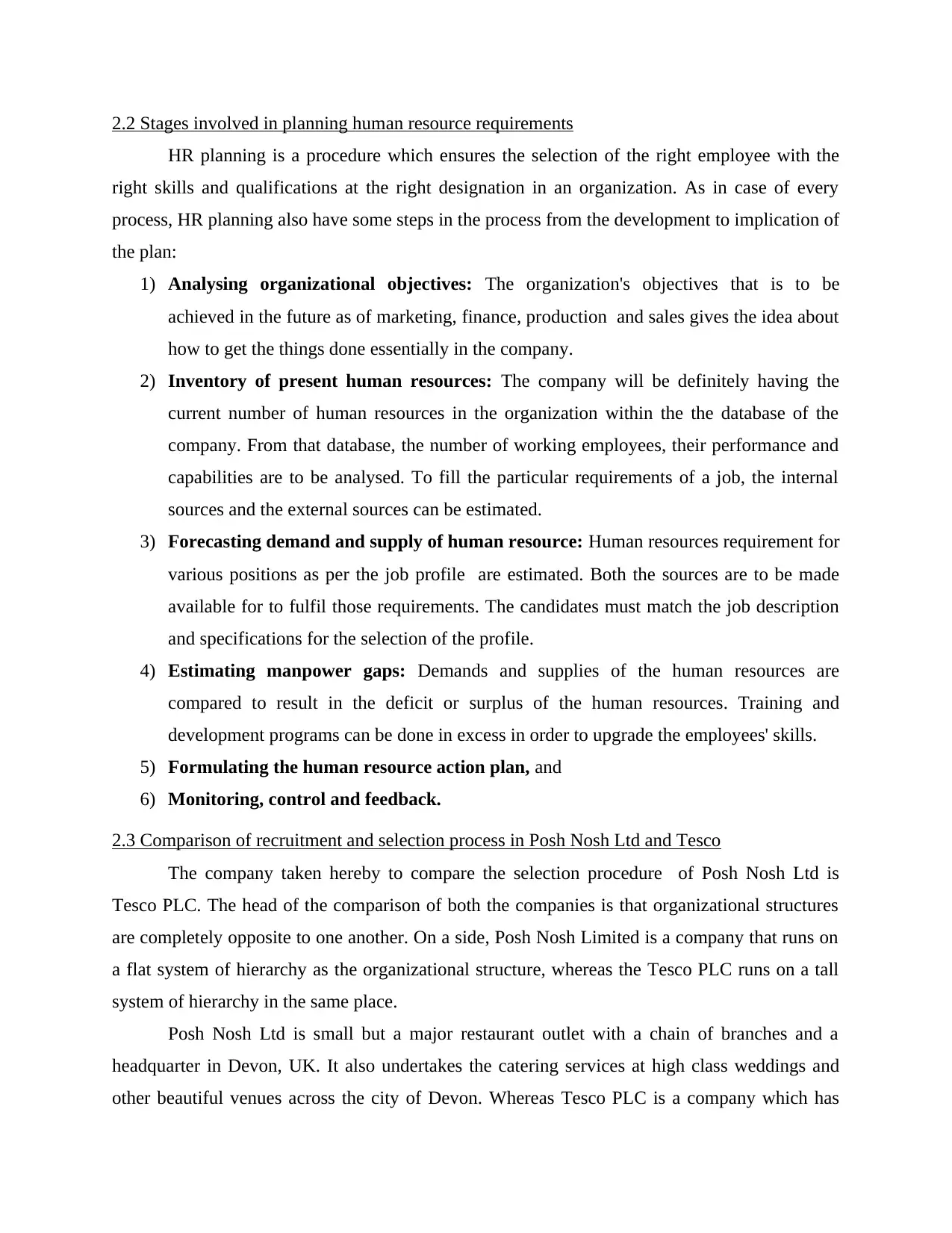
2.2 Stages involved in planning human resource requirements
HR planning is a procedure which ensures the selection of the right employee with the
right skills and qualifications at the right designation in an organization. As in case of every
process, HR planning also have some steps in the process from the development to implication of
the plan:
1) Analysing organizational objectives: The organization's objectives that is to be
achieved in the future as of marketing, finance, production and sales gives the idea about
how to get the things done essentially in the company.
2) Inventory of present human resources: The company will be definitely having the
current number of human resources in the organization within the the database of the
company. From that database, the number of working employees, their performance and
capabilities are to be analysed. To fill the particular requirements of a job, the internal
sources and the external sources can be estimated.
3) Forecasting demand and supply of human resource: Human resources requirement for
various positions as per the job profile are estimated. Both the sources are to be made
available for to fulfil those requirements. The candidates must match the job description
and specifications for the selection of the profile.
4) Estimating manpower gaps: Demands and supplies of the human resources are
compared to result in the deficit or surplus of the human resources. Training and
development programs can be done in excess in order to upgrade the employees' skills.
5) Formulating the human resource action plan, and
6) Monitoring, control and feedback.
2.3 Comparison of recruitment and selection process in Posh Nosh Ltd and Tesco
The company taken hereby to compare the selection procedure of Posh Nosh Ltd is
Tesco PLC. The head of the comparison of both the companies is that organizational structures
are completely opposite to one another. On a side, Posh Nosh Limited is a company that runs on
a flat system of hierarchy as the organizational structure, whereas the Tesco PLC runs on a tall
system of hierarchy in the same place.
Posh Nosh Ltd is small but a major restaurant outlet with a chain of branches and a
headquarter in Devon, UK. It also undertakes the catering services at high class weddings and
other beautiful venues across the city of Devon. Whereas Tesco PLC is a company which has
HR planning is a procedure which ensures the selection of the right employee with the
right skills and qualifications at the right designation in an organization. As in case of every
process, HR planning also have some steps in the process from the development to implication of
the plan:
1) Analysing organizational objectives: The organization's objectives that is to be
achieved in the future as of marketing, finance, production and sales gives the idea about
how to get the things done essentially in the company.
2) Inventory of present human resources: The company will be definitely having the
current number of human resources in the organization within the the database of the
company. From that database, the number of working employees, their performance and
capabilities are to be analysed. To fill the particular requirements of a job, the internal
sources and the external sources can be estimated.
3) Forecasting demand and supply of human resource: Human resources requirement for
various positions as per the job profile are estimated. Both the sources are to be made
available for to fulfil those requirements. The candidates must match the job description
and specifications for the selection of the profile.
4) Estimating manpower gaps: Demands and supplies of the human resources are
compared to result in the deficit or surplus of the human resources. Training and
development programs can be done in excess in order to upgrade the employees' skills.
5) Formulating the human resource action plan, and
6) Monitoring, control and feedback.
2.3 Comparison of recruitment and selection process in Posh Nosh Ltd and Tesco
The company taken hereby to compare the selection procedure of Posh Nosh Ltd is
Tesco PLC. The head of the comparison of both the companies is that organizational structures
are completely opposite to one another. On a side, Posh Nosh Limited is a company that runs on
a flat system of hierarchy as the organizational structure, whereas the Tesco PLC runs on a tall
system of hierarchy in the same place.
Posh Nosh Ltd is small but a major restaurant outlet with a chain of branches and a
headquarter in Devon, UK. It also undertakes the catering services at high class weddings and
other beautiful venues across the city of Devon. Whereas Tesco PLC is a company which has
⊘ This is a preview!⊘
Do you want full access?
Subscribe today to unlock all pages.

Trusted by 1+ million students worldwide
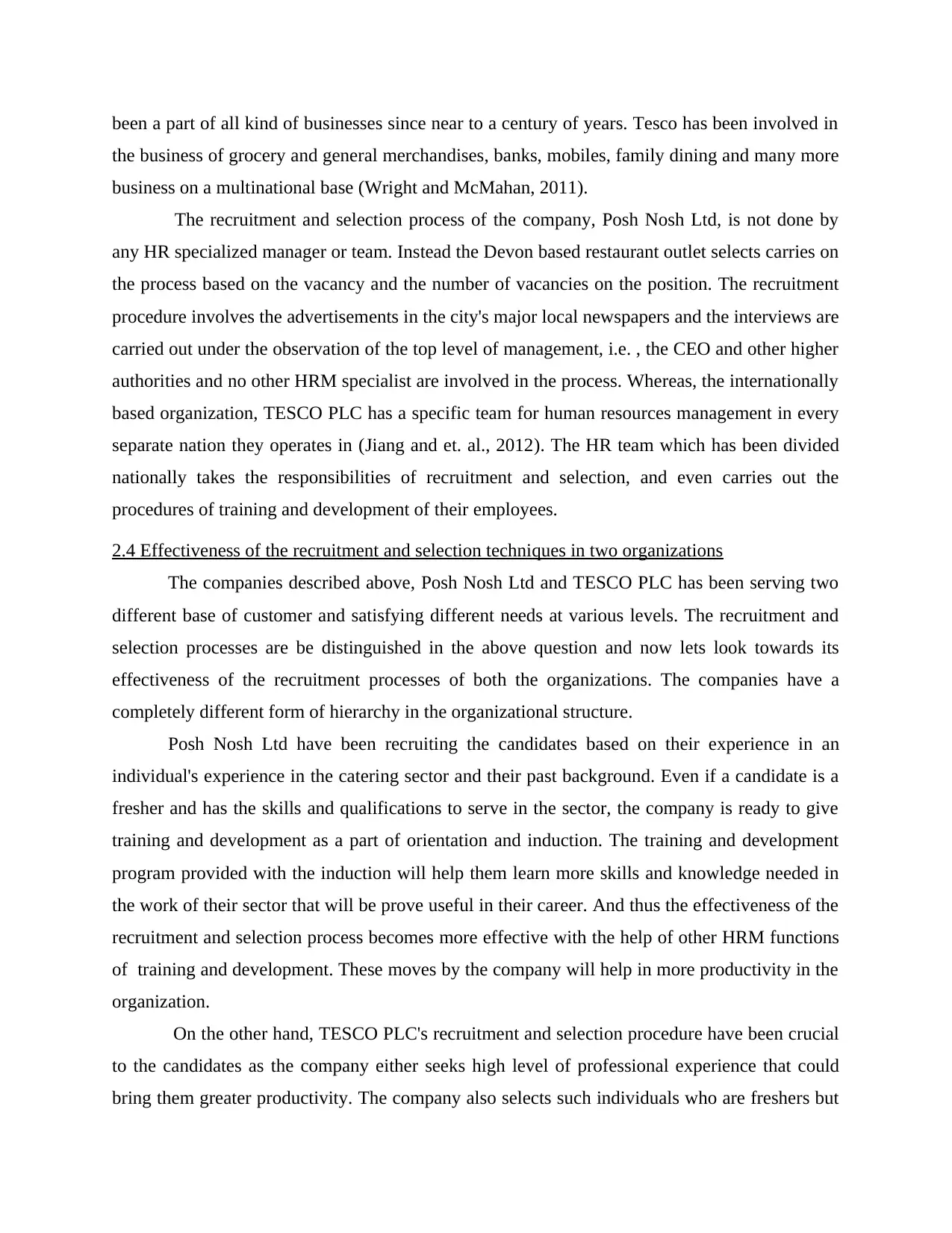
been a part of all kind of businesses since near to a century of years. Tesco has been involved in
the business of grocery and general merchandises, banks, mobiles, family dining and many more
business on a multinational base (Wright and McMahan, 2011).
The recruitment and selection process of the company, Posh Nosh Ltd, is not done by
any HR specialized manager or team. Instead the Devon based restaurant outlet selects carries on
the process based on the vacancy and the number of vacancies on the position. The recruitment
procedure involves the advertisements in the city's major local newspapers and the interviews are
carried out under the observation of the top level of management, i.e. , the CEO and other higher
authorities and no other HRM specialist are involved in the process. Whereas, the internationally
based organization, TESCO PLC has a specific team for human resources management in every
separate nation they operates in (Jiang and et. al., 2012). The HR team which has been divided
nationally takes the responsibilities of recruitment and selection, and even carries out the
procedures of training and development of their employees.
2.4 Effectiveness of the recruitment and selection techniques in two organizations
The companies described above, Posh Nosh Ltd and TESCO PLC has been serving two
different base of customer and satisfying different needs at various levels. The recruitment and
selection processes are be distinguished in the above question and now lets look towards its
effectiveness of the recruitment processes of both the organizations. The companies have a
completely different form of hierarchy in the organizational structure.
Posh Nosh Ltd have been recruiting the candidates based on their experience in an
individual's experience in the catering sector and their past background. Even if a candidate is a
fresher and has the skills and qualifications to serve in the sector, the company is ready to give
training and development as a part of orientation and induction. The training and development
program provided with the induction will help them learn more skills and knowledge needed in
the work of their sector that will be prove useful in their career. And thus the effectiveness of the
recruitment and selection process becomes more effective with the help of other HRM functions
of training and development. These moves by the company will help in more productivity in the
organization.
On the other hand, TESCO PLC's recruitment and selection procedure have been crucial
to the candidates as the company either seeks high level of professional experience that could
bring them greater productivity. The company also selects such individuals who are freshers but
the business of grocery and general merchandises, banks, mobiles, family dining and many more
business on a multinational base (Wright and McMahan, 2011).
The recruitment and selection process of the company, Posh Nosh Ltd, is not done by
any HR specialized manager or team. Instead the Devon based restaurant outlet selects carries on
the process based on the vacancy and the number of vacancies on the position. The recruitment
procedure involves the advertisements in the city's major local newspapers and the interviews are
carried out under the observation of the top level of management, i.e. , the CEO and other higher
authorities and no other HRM specialist are involved in the process. Whereas, the internationally
based organization, TESCO PLC has a specific team for human resources management in every
separate nation they operates in (Jiang and et. al., 2012). The HR team which has been divided
nationally takes the responsibilities of recruitment and selection, and even carries out the
procedures of training and development of their employees.
2.4 Effectiveness of the recruitment and selection techniques in two organizations
The companies described above, Posh Nosh Ltd and TESCO PLC has been serving two
different base of customer and satisfying different needs at various levels. The recruitment and
selection processes are be distinguished in the above question and now lets look towards its
effectiveness of the recruitment processes of both the organizations. The companies have a
completely different form of hierarchy in the organizational structure.
Posh Nosh Ltd have been recruiting the candidates based on their experience in an
individual's experience in the catering sector and their past background. Even if a candidate is a
fresher and has the skills and qualifications to serve in the sector, the company is ready to give
training and development as a part of orientation and induction. The training and development
program provided with the induction will help them learn more skills and knowledge needed in
the work of their sector that will be prove useful in their career. And thus the effectiveness of the
recruitment and selection process becomes more effective with the help of other HRM functions
of training and development. These moves by the company will help in more productivity in the
organization.
On the other hand, TESCO PLC's recruitment and selection procedure have been crucial
to the candidates as the company either seeks high level of professional experience that could
bring them greater productivity. The company also selects such individuals who are freshers but
Paraphrase This Document
Need a fresh take? Get an instant paraphrase of this document with our AI Paraphraser
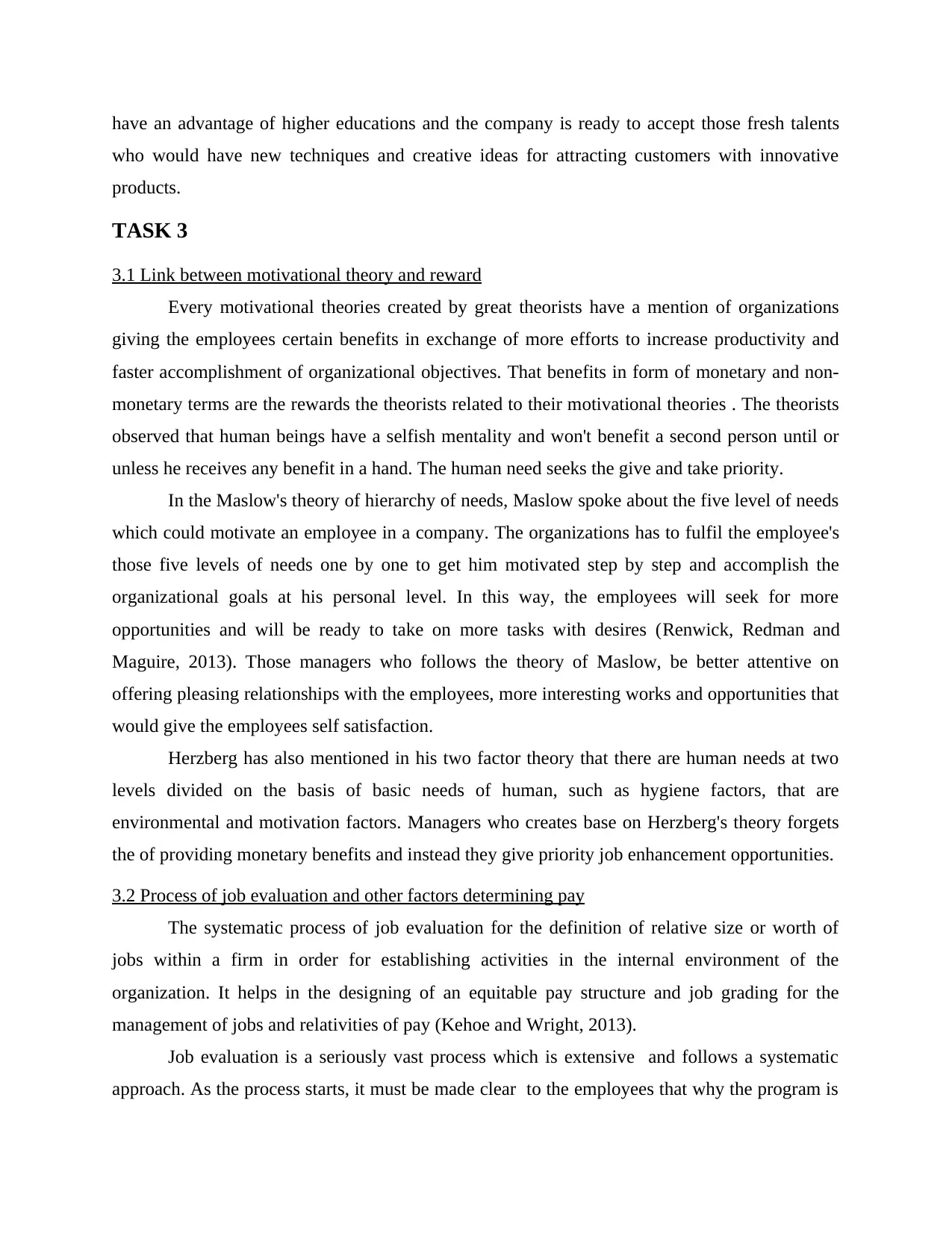
have an advantage of higher educations and the company is ready to accept those fresh talents
who would have new techniques and creative ideas for attracting customers with innovative
products.
TASK 3
3.1 Link between motivational theory and reward
Every motivational theories created by great theorists have a mention of organizations
giving the employees certain benefits in exchange of more efforts to increase productivity and
faster accomplishment of organizational objectives. That benefits in form of monetary and non-
monetary terms are the rewards the theorists related to their motivational theories . The theorists
observed that human beings have a selfish mentality and won't benefit a second person until or
unless he receives any benefit in a hand. The human need seeks the give and take priority.
In the Maslow's theory of hierarchy of needs, Maslow spoke about the five level of needs
which could motivate an employee in a company. The organizations has to fulfil the employee's
those five levels of needs one by one to get him motivated step by step and accomplish the
organizational goals at his personal level. In this way, the employees will seek for more
opportunities and will be ready to take on more tasks with desires (Renwick, Redman and
Maguire, 2013). Those managers who follows the theory of Maslow, be better attentive on
offering pleasing relationships with the employees, more interesting works and opportunities that
would give the employees self satisfaction.
Herzberg has also mentioned in his two factor theory that there are human needs at two
levels divided on the basis of basic needs of human, such as hygiene factors, that are
environmental and motivation factors. Managers who creates base on Herzberg's theory forgets
the of providing monetary benefits and instead they give priority job enhancement opportunities.
3.2 Process of job evaluation and other factors determining pay
The systematic process of job evaluation for the definition of relative size or worth of
jobs within a firm in order for establishing activities in the internal environment of the
organization. It helps in the designing of an equitable pay structure and job grading for the
management of jobs and relativities of pay (Kehoe and Wright, 2013).
Job evaluation is a seriously vast process which is extensive and follows a systematic
approach. As the process starts, it must be made clear to the employees that why the program is
who would have new techniques and creative ideas for attracting customers with innovative
products.
TASK 3
3.1 Link between motivational theory and reward
Every motivational theories created by great theorists have a mention of organizations
giving the employees certain benefits in exchange of more efforts to increase productivity and
faster accomplishment of organizational objectives. That benefits in form of monetary and non-
monetary terms are the rewards the theorists related to their motivational theories . The theorists
observed that human beings have a selfish mentality and won't benefit a second person until or
unless he receives any benefit in a hand. The human need seeks the give and take priority.
In the Maslow's theory of hierarchy of needs, Maslow spoke about the five level of needs
which could motivate an employee in a company. The organizations has to fulfil the employee's
those five levels of needs one by one to get him motivated step by step and accomplish the
organizational goals at his personal level. In this way, the employees will seek for more
opportunities and will be ready to take on more tasks with desires (Renwick, Redman and
Maguire, 2013). Those managers who follows the theory of Maslow, be better attentive on
offering pleasing relationships with the employees, more interesting works and opportunities that
would give the employees self satisfaction.
Herzberg has also mentioned in his two factor theory that there are human needs at two
levels divided on the basis of basic needs of human, such as hygiene factors, that are
environmental and motivation factors. Managers who creates base on Herzberg's theory forgets
the of providing monetary benefits and instead they give priority job enhancement opportunities.
3.2 Process of job evaluation and other factors determining pay
The systematic process of job evaluation for the definition of relative size or worth of
jobs within a firm in order for establishing activities in the internal environment of the
organization. It helps in the designing of an equitable pay structure and job grading for the
management of jobs and relativities of pay (Kehoe and Wright, 2013).
Job evaluation is a seriously vast process which is extensive and follows a systematic
approach. As the process starts, it must be made clear to the employees that why the program is
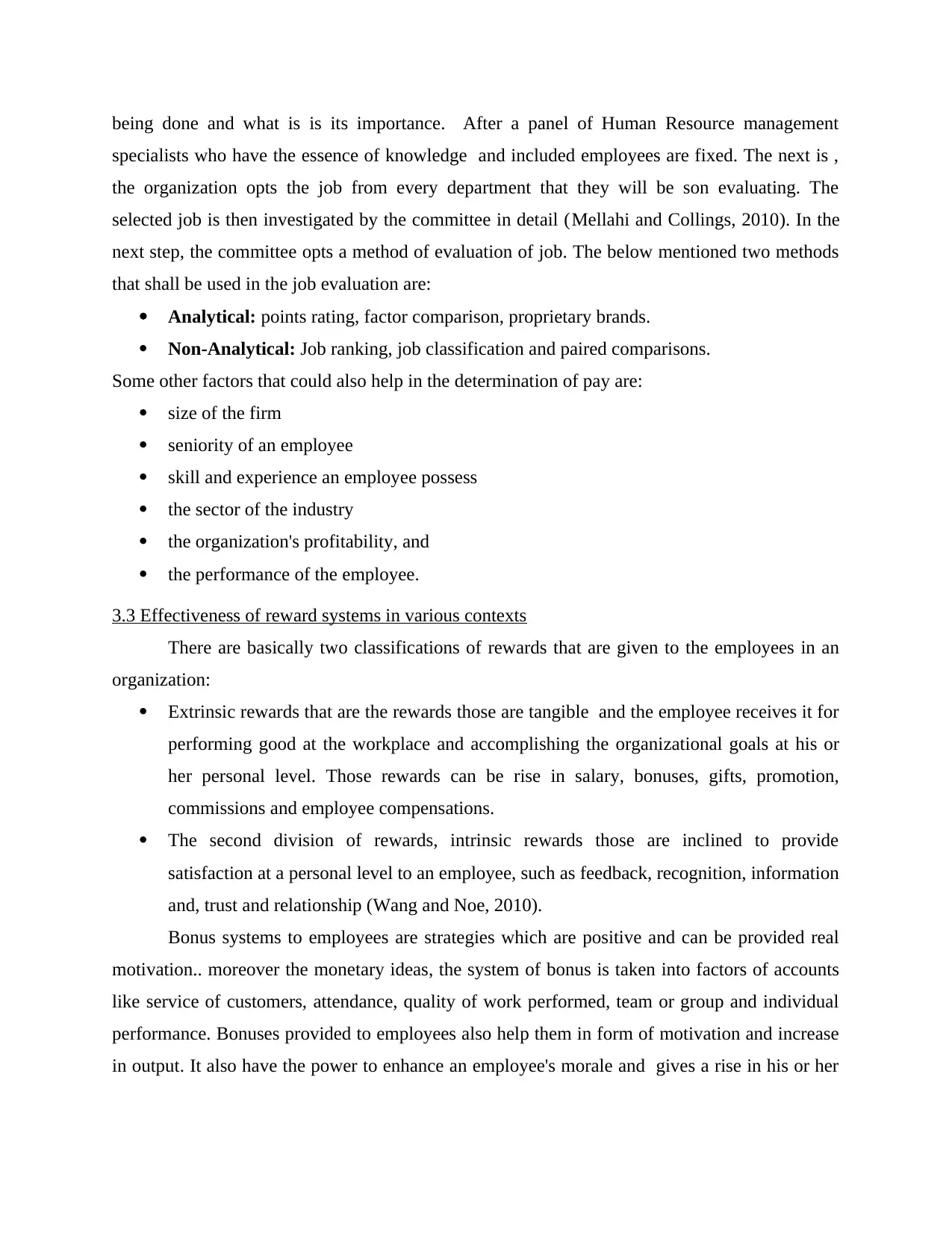
being done and what is is its importance. After a panel of Human Resource management
specialists who have the essence of knowledge and included employees are fixed. The next is ,
the organization opts the job from every department that they will be son evaluating. The
selected job is then investigated by the committee in detail (Mellahi and Collings, 2010). In the
next step, the committee opts a method of evaluation of job. The below mentioned two methods
that shall be used in the job evaluation are:
Analytical: points rating, factor comparison, proprietary brands.
Non-Analytical: Job ranking, job classification and paired comparisons.
Some other factors that could also help in the determination of pay are:
size of the firm
seniority of an employee
skill and experience an employee possess
the sector of the industry
the organization's profitability, and
the performance of the employee.
3.3 Effectiveness of reward systems in various contexts
There are basically two classifications of rewards that are given to the employees in an
organization:
Extrinsic rewards that are the rewards those are tangible and the employee receives it for
performing good at the workplace and accomplishing the organizational goals at his or
her personal level. Those rewards can be rise in salary, bonuses, gifts, promotion,
commissions and employee compensations.
The second division of rewards, intrinsic rewards those are inclined to provide
satisfaction at a personal level to an employee, such as feedback, recognition, information
and, trust and relationship (Wang and Noe, 2010).
Bonus systems to employees are strategies which are positive and can be provided real
motivation.. moreover the monetary ideas, the system of bonus is taken into factors of accounts
like service of customers, attendance, quality of work performed, team or group and individual
performance. Bonuses provided to employees also help them in form of motivation and increase
in output. It also have the power to enhance an employee's morale and gives a rise in his or her
specialists who have the essence of knowledge and included employees are fixed. The next is ,
the organization opts the job from every department that they will be son evaluating. The
selected job is then investigated by the committee in detail (Mellahi and Collings, 2010). In the
next step, the committee opts a method of evaluation of job. The below mentioned two methods
that shall be used in the job evaluation are:
Analytical: points rating, factor comparison, proprietary brands.
Non-Analytical: Job ranking, job classification and paired comparisons.
Some other factors that could also help in the determination of pay are:
size of the firm
seniority of an employee
skill and experience an employee possess
the sector of the industry
the organization's profitability, and
the performance of the employee.
3.3 Effectiveness of reward systems in various contexts
There are basically two classifications of rewards that are given to the employees in an
organization:
Extrinsic rewards that are the rewards those are tangible and the employee receives it for
performing good at the workplace and accomplishing the organizational goals at his or
her personal level. Those rewards can be rise in salary, bonuses, gifts, promotion,
commissions and employee compensations.
The second division of rewards, intrinsic rewards those are inclined to provide
satisfaction at a personal level to an employee, such as feedback, recognition, information
and, trust and relationship (Wang and Noe, 2010).
Bonus systems to employees are strategies which are positive and can be provided real
motivation.. moreover the monetary ideas, the system of bonus is taken into factors of accounts
like service of customers, attendance, quality of work performed, team or group and individual
performance. Bonuses provided to employees also help them in form of motivation and increase
in output. It also have the power to enhance an employee's morale and gives a rise in his or her
⊘ This is a preview!⊘
Do you want full access?
Subscribe today to unlock all pages.

Trusted by 1+ million students worldwide
1 out of 16
Related Documents
Your All-in-One AI-Powered Toolkit for Academic Success.
+13062052269
info@desklib.com
Available 24*7 on WhatsApp / Email
![[object Object]](/_next/static/media/star-bottom.7253800d.svg)
Unlock your academic potential
Copyright © 2020–2025 A2Z Services. All Rights Reserved. Developed and managed by ZUCOL.





